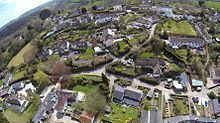 | ||
Trusham is a small village in the Teign Valley just outside Chudleigh between Newton Abbot and Exeter in Devon. The name originates from the Celtic 'Trisma', considered by Ekwall to mean ‘brushwood’ or ‘fallen leaves’, became 'Trisme' for about four hundred years, and then in the 16th century 'Tryssame' or 'Trysham'. It has one pub - the Cridford Inn - probably the oldest pub/inn in Devon and possibly the oldest in England. It was quoted in "The Which Guide to Country Pubs" dated March 1988 that the main site of the now, Cridford Inn, dates back to 825AD - well before Alfred the Great and was originally inhabited by the early Britons/Celts. However, King Athelstan of the English notably expelled "that filthy race" (the Britons) from Exeter and the surrounding area, as far as Cornwall, in 927AD. The building was presumably remodelled in 1081, as a small cobbled area in which was set a crude mosaic, made of dolerite and quartz, bearing the initials HJ and the year 1081 was discovered during renovations in 1988. This mosaic is thankfully preserved and displayed under glass in the inn's restaurant. The Cridford had also previously served as a nunnery and a farm. In 1086 it is understood to be one of the nine small-holdings mentioned in the “Domesday Book”, and by then belonged to the Abbey of Buckfast in the Manor of Trusham. During the early 13th to 15th Centuries, the building itself was a farmhouse and the stained glass mullion window in the bar is from this period and is possibly the earliest surviving example of a Medieval domestic window in England. It is also believed that The Cridford Inn is home to two ghosts,; one is said to be a Nun from the very early history of the property and a second is a Cavalier from Trusham's conflict with Ashton, (a nearby village) during the Civil war of 1642-46. In more recent times, the buildings reverted to farm use and as a Devon Longhouse was previously known as Cridford Farm, the home of one branch of the Cridford family who have a long history in Devon. Members of the Cridford family still live in Devon.
Map of Trusham, Newton Abbot, UK
The church of St Michael, (erected 1259) and the aisle added in 1430, is an ancient building of stone in the early English and Perpendicular styles with traces of Norman work... the church was thoroughly restored in 1865, when the stained east window and a smaller one were inserted as memorials to the Rev. William Edward Brendon, who died in 1864. There is also a memorial to John Stooke which mentions a charity he set up for the church and the poor of nearby Bovey Tracey. The story, first recorded in 1709, goes that in 1646 an officer in the Royalist army was gambling at Bovey when he was cornered by Roundheads. Before he was slain, he threw his bag of winnings to a servant, who, (before he was also slain) threw them over a hedge, where they were found by Stooke, then a humble farmer's boy. Stooke's fortune was founded on his lucky find. Bovey's altar fund still receives a small annual sum from the charity.
Trusham is also famous for being the ancestral home of the Causley family, whose descendants include the poet Charles Causley and the folk singer Jim Causley. Causley's poem 'Trusham' is an account of a return he made to the village in his later years: a poignant reflection on one's family roots, what it is to be distant from those, and the legacies we leave behind us. Jim Causley's setting of this poem—amongst a number of other poems by his distant relation—is a fine piece of modern song-setting, and is available on the album 'Cyprus Well'. A later poem, 'The Prodigal Son', recounts a further visit by Causley to his ancestral village, linking once again the local geography, history and landscape with the First World War and his own family memories.
In September 2007, Trusham held the first Charles Causley festival in conjunction with the Charles Causley Society of Launceston. There is a plaque in the village to celebrate Causley's life and the Charles Causley Society hold regular events in Trusham such as Causley readings and poems set to music, hog roasts and barn dancing.
The Trusham of many years ago had the services of shoemakers, dressmakers and thatchers. There was the church, a school, a shop, a post office and a pub, as well as links to the outside world by bus and train. At the bottom of the village it is still possible to see the now disused and privately owned Trusham railway station which was part of the Teign Valley Line. While the church no longer has a resident vicar, it plays an important part in village life, as does the only pub, the Cridford Inn. Although the school closed in November 1948, its Victorian building, now the Village Hall, is the focus of various village activities.
It is notable that the Doomsday survey of 1086 recorded a settlement of 23 households, (4 villagers. 9 smallholders. 10 slaves). Eight hundred years later, the 1881 Census shows a very small growth, with 41 households and a population of 177, however, in 1901, Kelly’s Directory of Devonshire (published 1902) the population had fallen to 165 and by 2001, whilst the number of households had increased to 60, the population had fallen further to 144.
Trusham is situated on the western side of the 250m high Haldon Hills, roughly 90m above the river Teign, which forms the Dartmoor National Park boundary and is just over half-a-mile away. The village is accessed via minor roads which are predominately single track with passing places. The A38 passes within 2 miles at Chudleigh. The centre of the village has the O S grid reference SX 854 821 and for sat nav users the postcode is TQ13 0NW.
